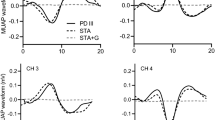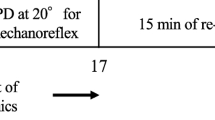Abstract
Paced breathing and rhythmical skeletal muscle tension (RSMT) at an individual’s resonance frequency [~ 6 breaths or contractions per min (cpm)] can stimulate the arterial and vascular tone baroreflexes. Lehrer (Appl Psychophysiol Biofeedback 1–10, 2022, https://doi.org/10.1007/s10484-022-09535-5) has explained that the stimulation rate is important, not the modality. Early RSMT protocols differed in the muscles recruited and whether legs were crossed or uncrossed (in France et al. Clin Physiol Funct Imaging 26: 21–25, 2006, https://doi.org/10.1111/j.1475-097X.2005.00642.x; Leher et al. Biol Psychol 81: 24–30, 2009, https://doi.org/10.1016/j.biopsycho.2009.01.003; Vaschillo et al. Psychophysiology, 48: 927–936, 2011, https://doi.org/10.1111/j.1469-8986.2010.01156.x). Whereas core muscle RSMT with crossed legs and wrist-ankle RSMT with uncrossed legs produced resonance effects, researchers have not directly compared the effect of these exercises on respiratory sinus arrhythmia (RSA) and low-frequency (LF) power. The current within-subjects experiment investigated whether crossing the legs and recruiting core muscles enhances wrist-ankle RSMT effects on RSA and LF power. We trained 35 participants to complete 6-cpm wrist-ankle RSMT (ankles uncrossed), 6-cpm wrist-core-ankle RSMT (ankles crossed), and a control condition in which participants sat quietly (ankles uncrossed) without performing RSMT. We predicted that 6-cpm wrist-core-ankle RSMT would produce greater heart rate (HR), HR Max-HR Min, and LF power than the other conditions. The experimental findings supported our predictions. Both RSMT conditions produced greater HR, HR Max-HR Min, and LF power than the control condition. Wrist-core-ankle yielded greater HR and HR Max-HR Min than wrist-ankle RSMT. Future research should compare wrist-ankle and wrist-core-ankle RSMT with legs crossed. The practical implication for HRV biofeedback training is that wrist-core-ankle RSMT with legs crossed may more powerfully stimulate the baroreflex than wrist-ankle RSMT with legs uncrossed.






Similar content being viewed by others

References
Akselrod, S., Gordon, D., Ubel, F. A., Shannon, D. C., Berger, A. C., & Cohen, R. J. (1981). Power spectrum analysis of heart rate fluctuation: A quantitative probe of beat-to-beat cardiovascular control. Science, 213, 220–222. https://doi.org/10.1126/science.6166045
Angelone, A., & Coulter, N. A., Jr. (1964). Respiratory sinus arrhythmia: A frequency dependent phenomenon. Journal of Applied Physiology, 19, 479–482. https://doi.org/10.1152/jappl.1964.19.3.479
Berntson, G. G., Quigley, K. S., Norman, G. J., & Lozano, D. (2017). Cardiovascular psychophysiology. In J. T. Cacioppo, L. G. Tassinary, & G. G. Berntson (Eds.), Handbook of psychophysiology (4th ed.). Cambridge University Press.
Christou, D. D., Jones, P. P., & Seals, D. R. (2003). Baroreflex buffering in sedentary and endurance exercise–trained healthy men. Hypertension, 41, 1219–1222. https://doi.org/10.1161/01.HYP.0000072011.17095.AE
Cohen, H., & Benjamin, J. (2006). Power spectrum analysis and cardiovascular morbidity in anxiety disorders. Autonomic Neuroscience: Basic & Clinical, 128(1–2), 1–8. https://doi.org/10.1016/j.autneu.2005.06.007
Dahr, A. K., Lambert, G. W., & Barton, D. A. (2016). Depression and cardiovascular disease: Psychobiological mechanisms. In M. E. Alvarenga & D. Byrne (Eds.), Handbook of psychocardiology. Springer.
Dell’Acqua, C., Dal Bò, E., Benvenuti, S. M., & Palomba, D. (2020). Reduced heart rate variability is associated with vulnerability to depression. Journal of Affective Disorders Reports, 1, 100006. https://doi.org/10.1016/j.jadr.2020.100006
Forte, G., Favieri, F., & Casagrande, M. (2019). Heart rate variability and cognitive function: A systematic review. Frontiers in Neuroscience, 13, 710. https://doi.org/10.3389/fnins.2019.00710
France, C. R., France, J. L., & Patterson, S. M. (2006). Blood pressure and cerebral oxygenation responses to skeletal muscle tension: A comparison of two physical maneuvers to prevent vasovagal reactions. Clinical Physiology and Functional Imaging, 26, 21–25. https://doi.org/10.1111/j.1475-097X.2005.00642.x
Goessl, V. C., Curtiss, J. E., & Hofmann, S. G. (2017). The effect of heart rate variability biofeedback training on stress and anxiety: A meta-analysis. Psychological Medicine, 47, 2578–2586. https://doi.org/10.1017/S0033291717001003
Goldstein, D. S., Bentho, O., Park, M. Y., & Sharabi, Y. (2011). Low-frequency power of heart rate variability is not a measure of cardiac sympathetic tone but may be a measure of modulation of cardiac autonomic outflows by baroreflexes. Experimental Physiology, 96, 1255–1261. https://doi.org/10.1113/expphysiol.2010.056259
Grodins, F. S., & James, G. (1963). Mathematical models of respiratory regulation. Annals of the New York Academy of Sciences, 109, 852–868. https://doi.org/10.1111/j.1749-6632.1963.tb13510.x
Hammer, P. E., & Saul, J. P. (2005). Resonance in a mathematical model of baroreflex control: Arterial blood pressure waves accompanying postural stress. American Journal of Physiology-Regulatory, Integrative and Comparative Physiology, 288, R1637–R1648. https://doi.org/10.1152/ajpregu.00050.2004
Hansen, A. L., Johnsen, B. H., & Thayer, J. F. (2009). Relationship between heart rate variability and cognitive function during threat of shock. Anxiety, Stress, and Coping, 22(1), 77–89. https://doi.org/10.1080/10615800802272251
Hartmann, R., Schmidt, F. M., Sander, C., & Hegerl, U. (2019). Heart rate variability as indicator of clinical state in depression. Frontiers in Psychiatry, 9, 735. https://doi.org/10.3389/fpsyt.2018.00735
Hayano, J., & Yuda, E. (2019). Pitfalls of assessment of autonomic function by heart rate variability. Journal of Physiological Anthropology, 38, 3. https://doi.org/10.1186/s40101-019-0193-2
Just, A., Wittmann, U., Nafz, B., Wagner, C. D., Ehmke, H., Kirchheim, H. R., & Persson, P. B. (1994). The blood pressure buffering capacity of nitric oxide by comparison to the baroreceptor reflex. American Journal of Physiology-Heart and Circulatory Physiology, 267, H521–H527. https://doi.org/10.1152/ajpheart.1994.267.2.H521
Kazdin, A. E. (2016). Research design in clinical psychology. Pearson.
Kim, H. G., Cheon, E. J., Bai, D. S., Lee, Y. H., & Koo, B. H. (2018). Stress and heart rate variability: A meta-analysis and review of the literature. Psychiatry Investigation, 15(3), 235–245. https://doi.org/10.30773/pi.2017.08.17
Lehrer, P. M. (2007). Biofeedback training to increase heart rate variability. In P. M. Lehrer, R. M. Woolfolk, & W. E. Sime (Eds.), Principles and practice of stress management (3rd ed.). The Guilford Press.
Lehrer, P. (2022). My life in HRV biofeedback research. Applied Psychophysiology and Biofeedback. https://doi.org/10.1007/s10484-022-09535-5
Lehrer, P., & Eddie, D. (2013). Dynamic processes in regulation and some implications for biofeedback and biobehavioral interventions. Applied Psychophysiology and Biofeedback, 38, 143–155. https://doi.org/10.1007/s10484-013-9217-6
Lehrer, P., Kaur, K., Sharma, A., Shah, K., Huseby, R., Bhavsar, J., Sgobba, P., & Zhang, Y. (2020). Heart rate variability biofeedback improves emotional and physical health and performance: A systematic review and meta-analysis. Applied Psychophysiology and Biofeedback, 45, 109–129. https://doi.org/10.1007/s10484-020-09466-z
Lehrer, P., Vaschillo, E., Trost, Z., & France, C. R. (2009). Effects of rhythmical muscle tension at 0.1 Hz on cardiovascular resonance and the baroreflex. Biological Psychology, 81, 24–30. https://doi.org/10.1016/j.biopsycho.2009.01.003
Lehrer, P. M., Vaschillo, E. V., & Vaschillo, B. (2004). Heartbeat synchronizes with respiratory rhythm only under specific circumstances. Chest, 126(4), 1385–1386. https://doi.org/10.1016/S0012-3692(15)31329-5
Lehrer, P. M., Vaschillo, E., Vaschillo, B., Lu, S. E., Eckberg, D. L., Edelberg, R., Shih, W. J., Lin, Y., Kuusela, T. A., Tahvanainen, K. U. O., & Hamer, R. M. (2003). Heart rate variability biofeedback increases baroreflex gain and peak expiratory flow. Psychosomatic Medicine, 65, 796–805. https://doi.org/10.1097/01.psy.0000089200.81962.19
Pinar, R., Sabuncu, N., & Oksay, A. (2004). Effects of crossed leg on blood pressure. Blood Pressure, 13, 252–254. https://doi.org/10.1080/08037050410000903
Pizzoli, S. F. M., Marzorati, C., Gatti, D., Monzani, D., Mazzocco, K., & Pravettoni, G. (2021). A meta-analysis on heart rate variability biofeedback and depressive symptoms. Science and Reports, 11, 6650. https://doi.org/10.1038/s41598-021-86149-7
Salkind, N. J. (2010). Encyclopedia of research design. Sage. https://doi.org/10.4135/9781412961288
Schneider, M., & Schwerdtfeger, A. (2020). Autonomic dysfunction in posttraumatic stress disorder indexed by heart rate variability: A meta-analysis. Psychological Medicine, 50(12), 1937–1948. https://doi.org/10.1017/S003329172000207X
Shaffer, F., Moss, D., & Meehan, Z. M. (2022). Rhythmic skeletal muscle tension increases heart rate variability at 1 and 6 contractions per minute. Applied Psychophysiology and Biofeedback. https://doi.org/10.1007/s10484-022-09541-7
Stevens, S. L., Wood, S., Koshiaris, C., Law, K., Glasziou, P., Stevens, R. J., & McManus, R. J. (2016). Blood pressure variability and cardiovascular disease: Systematic review and meta-analysis. BMJ, 4098, 354–362. https://doi.org/10.1136/bmj.i4098
Task Force of the European Society of Cardiology and the North American Society of Pacing and Electrophysiology. (1996). Heart rate variability: Standards of measurement, physiological interpretation, and clinical use. Circulation, 93, 1043–1065.
Titelman, G. Y. (1996). Random House dictionary of popular proverbs and sayings. Random House.
Van de Vooren, H., Gademan, M. G., Swenne, C. A., TenVoorde, B. J., Schalij, M. J., & Van der Wall, E. E. (2007). Baroreflex sensitivity, blood pressure buffering, and resonance: What are the links? Computer simulation of healthy subjects and heart failure patients. Journal of Applied Physiology, 102, 1348–1356. https://doi.org/10.1152/japplphysiol.00158.2006
Vaschillo, E. G., Bates, M. E., Vaschillo, B., Lehrer, P., Udo, T., Mun, E. Y., & Ray, S. (2008). Heart rate variability response to alcohol, placebo, and emotional picture cue challenges: Effects of 0.1-Hz stimulation. Psychophysiology, 45, 847–858. https://doi.org/10.1111/j.1469-8986.2008.00673.x
Vaschillo, E., Lehrer, P., Rishe, N., & Konstantinov, M. (2002). Heart rate variability biofeedback as a method for assessing baroreflex function: A preliminary study of resonance in the cardiovascular system. Applied Psychophysiology and Biofeedback, 27, 1–27. https://doi.org/10.1023/A:1014587304314
Vaschillo, E., Vaschillo, B., & Lehrer, P. (2004). Heartbeat synchronizes with respiratory rhythm only under specific circumstances. Chest, 126, 1385–1386. https://doi.org/10.1016/S0012-3692(15)31329-5
Vaschillo, E. G., Vaschillo, B., Buckman, J. F., Pandina, R. J., & Bates, M. E. (2010). The investigation and clinical significance of resonance in the heart rate and vascular tone baroreflexes. International Joint Conference on Biomedical Engineering Systems and Technologies (pp. 224–237). Springer.
Vaschillo, E. G., Vaschillo, B., & Lehrer, P. M. (2006). Characteristics of resonance in heart rate variability stimulated by biofeedback. Applied Psychophysiology and Biofeedback, 31, 129–142. https://doi.org/10.1007/s10484-006-9009-3
Vaschillo, E. G., Vaschillo, B., Pandina, R. J., & Bates, M. E. (2011). Resonances in the cardiovascular system caused by rhythmical muscle tension. Psychophysiology, 48, 927–936. https://doi.org/10.1111/j.1469-8986.2010.01156.x
Acknowledgements
We thank the students who participated in this research and the research assistants who helped collect these data.
Funding
No funding sources to declare.
Author information
Authors and Affiliations
Contributions
Zachary Meehan wrote the introduction, methods, and results of the manuscript, as well as created the table and figures to display the results (Table 1 and Figures 4, 5, and 6). Dr. Fred Shaffer and his lab designed the experiment, obtained IRB approval, and collected the data. Dr. Shaffer also completed analyses with Zachary Meehan as well as wrote the discussion of the manuscript. Dr. Shaffer created the figures depicting the procedures and modality placements (Figures 1, 2, and 3). Both Zachary Meehan and Dr. Fred Shaffer reviewed the manuscript and provided edits.
Corresponding author
Ethics declarations
Conflict of interest
No authors have conflicts of interest to report.
Additional information
Publisher's Note
Springer Nature remains neutral with regard to jurisdictional claims in published maps and institutional affiliations.
Rights and permissions
Springer Nature or its licensor (e.g. a society or other partner) holds exclusive rights to this article under a publishing agreement with the author(s) or other rightsholder(s); author self-archiving of the accepted manuscript version of this article is solely governed by the terms of such publishing agreement and applicable law.
About this article
Cite this article
Meehan, Z.M., Shaffer, F. Adding Core Muscle Contraction to Wrist-Ankle Rhythmical Skeletal Muscle Tension Increases Respiratory Sinus Arrhythmia and Low-Frequency Power. Appl Psychophysiol Biofeedback 48, 127–134 (2023). https://doi.org/10.1007/s10484-022-09568-w
Accepted:
Published:
Issue Date:
DOI: https://doi.org/10.1007/s10484-022-09568-w



